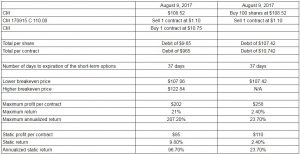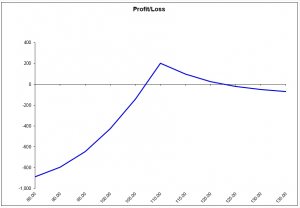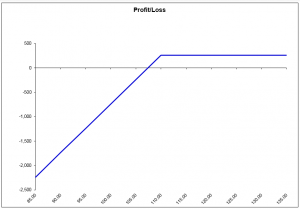Writing Calls Covered by Long-Term Call Options on CM Shares

As the following graph shows, share prices for Canadian Imperial Bank of Commerce (CM) peaked in February 2017, after which they fell by almost 15% to settle at around $104. Since then, CM is up slightly and trying to break through $110, but this resistance level may be difficult to breach, since it was a support level in December 2016 and January 2017. In technical analysis, it is common knowledge that once a support level has been crossed, it can become a resistance level. This is what appears to be happening here. Furthermore, we can see that CM peaked at $104 at the end of August 2016, and this peak now appears to be serving as a support level. Prices may therefore be relatively stable for a while, moving in a channel bound by $104 and $110. The investor who still believes in the long-term potential of CM may want to take advantage of the time value decay in the short term by writing calls covered not by shares, but by long-term call options. The advantage to holding long-term call options over shares lies in their low cost in comparison to paying $108.52 per share for CM, which was the price when this text was written on August 9, 2017.

Writing Calls Covered with Long-Term Options
Writing Covered Calls: Table Comparing Holding Long-Term Options with Holding Shares

Profit and Loss Diagram upon Expiration of the Short-term Options when Writing Call Options Covered by Long-Term Options

Profit and Loss Diagram upon Expiration when Writing Call Options Covered by Shares

The above graphs and table compare writing calls covered by long-term options with writing calls covered by shares. As you can see, the profit and loss diagrams of these two positions are similar but not identical. Using long-term options results in a potential loss above the upper breakeven price of $122.84, while using shares shows a continuous maximum profit of $258 per contract above the strike price of $110. A maximum profit of $202 per long-term option contract is obtained when CM closes exactly on the $110 strike price upon expiration of the short-term options on September 15, 2017. This $202 potential profit represents a 21% return on invested capital for the 37-day period, and an annualized return of 207.2% if we could repeat this performance every 37 days for a full year. The maximum profit of $258 per contract when using shares represents a return of 2.4% for the 37-day period and an annualized return of 23.7%.
The static return for the long-term options (the return obtained if the price of CM remains relatively unchanged from now until the options expire on September 15, 2017) is 9.8% for the 37-day period (96.7% annualized return), and 2.4% for the strategy using shares (23.7% annualized return).
The position becomes a losing proposition below the breakeven prices of $107.06 when holding long-term options and $107.42 when holding shares. We will have greater leeway in both of the strategies if the stock price rises compared to if it falls. Consequently, defensive measures should be taken if CM falls below the $104 support level. Should the price fall, the simplest solution would be to liquidate the position entirely, or roll over the call options we have written by buying them back, and selling others at a lower strike price.
As we can see, using long-term options allows us to obtain better returns on our invested capital compared to holding shares, which requires a larger investment of capital. Also, in the event that the stock price falls suddenly and precipitously, our loss is limited to the position’s debit position, which is $965 for the long-term options. This compares to a much greater loss on the strategy of holding shares.
In the proposed scenario of writing covered calls, the use of long-term options therefore represents an excellent alternative to using shares.
Good luck with your trading, and have a good week!
The strategies presented in this blog are for information and training purposes only, and should not be interpreted as recommendations to buy or sell any security. As always, you should ensure that you are comfortable with the proposed scenarios and ready to assume all the risks before implementing an option strategy.
President
Monetis Financial Corporation
Martin Noël earned an MBA in Financial Services from UQÀM in 2003. That same year, he was awarded the Fellow of the Institute of Canadian Bankers and a Silver Medal for his remarkable efforts in the Professional Banking Program. Martin began his career in the derivatives field in 1983 as an options market maker for options, on the floor at the Montréal Exchange and for various brokerage firms. He later worked as an options specialist and then went on to become an independent trader. In 1996, Mr. Noël joined the Montréal Exchange as the options market manager, a role that saw him contributing to the development of the Canadian options market. In 2001, he helped found the Montréal Exchange’s Derivatives Institute, where he acted as an educational advisor. Since 2005, Martin has been an instructor at UQÀM, teaching a graduate course on derivatives. Since May 2009, he has dedicated himself full-time to his position as the president of CORPORATION FINANCIÈRE MONÉTIS, a professional trading and financial communications firm. Martin regularly assists with issues related to options at the Montréal Exchange.
One Comment
Leave a Reply
The information provided on this website, including financial and economic data, quotes and any analysis or interpretation thereof, is provided solely for information purposes and shall not be construed in any jurisdiction as providing any advice or recommendation with respect to the purchase or sale of any derivative instrument, underlying security or any other financial instrument or as providing legal, accounting, tax, financial or investment advice. Bourse de Montréal Inc. recommends that you consult your own advisors in accordance with your needs before making decision to take into account your particular investment objectives, financial situation and individual needs.
All references on this website to specifications, rules and obligations concerning a product are subject to the rules, policies and procedures of Bourse de Montréal Inc. and its clearinghouse, the Canadian Derivatives Clearing Corporation, which prevail over the content of this website. Although care has been taken in the preparation of the documents published on this website, Bourse de Montréal Inc. and/or its affiliates do not guarantee the accuracy or completeness of the information published on this website and reserve the right to amend or review, at any time and without prior notice, the content of these documents. Neither Bourse de Montréal Inc. nor any of its affiliates, directors, officers, employees or agents shall be liable for any damages, losses or costs incurred as a result of any errors or omissions on this website or of the use of or reliance upon any information appearing on this website.
BAX®, CADC®, CGB®, CGF®, CGZ®, LGB®, MX®, OBX®, OGB®, OIS-MX®, ONX®, SCF®, SXA®, SXB®, SXF®, SXH®, SXM®, SXO®, SXY®, and USX® are registered trademarks of the Bourse. OBW™, OBY™, OBZ™, SXK™, SXJ™, SXU™, SXV™, Montréal Exchange and the Montréal Exchange logo are trademarks of the Bourse. All other trademarks used are the property of their respective owners.
© 2024 Bourse de Montréal Inc. All Rights Reserved.

What do you consider a long term option? Which delta is appropriate? I don’t see which expiration cycle that is given in this article for the long dated call option.